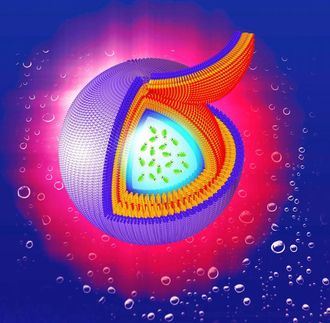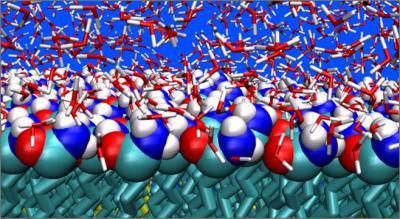Surprising Discovery Leads to New Understanding of Water Quality
Scientists at the U.S. Department of Energy's Argonne National Laboratory have discovered new ways that ions interact with mineral surfaces in water, opening a door to new knowledge on how contaminants travel in the environment. The insight, published in today's issue of Physical Review Letters, leads to a better understanding of the factors that determine water quality.
Water - colorless, odorless and tasteless - may seem simple, but its interactions with minerals can be difficult to study. Ions, which range from nutrients such as calcium, to contaminants such as lead, are present in natural waters, but their transport is often limited by adsorption to mineral surfaces. The more scientists can understand about the interaction of minerals with water and ions, the more effectively they can control water quality in our environment, and Argonne's research in this area is making a leading contribution to the field.
Contrary to generally held scientific assumptions, the simple textbook description of how ions adsorb to mineral-water interfaces has been shown to not be universally true.
"Ions are known to carry a hydration shell in water," said Argonne physicist Paul Fenter. "Previously, it was thought that ions either adsorb to a mineral surface with this shell intact as an outer-sphere ion, or remove part of this shell to directly bind to the mineral as an inner-sphere ion. We now know that this is not just a black and white difference, but have discovered new shades of gray by showing that outer-sphere and inner-sphere species of the same ion can co-exist."
This revelation was the outcome of a new element-specific method developed to understand the behavior of ions at the interface between minerals and liquids, like water.
According to Argonne chemist Changyong Park, "Conventional methods provided no direct sensitivity to observing this behavior. Outer-sphere species were almost invisible and extremely difficult to identify. There was just no way to see the co-existence of both species previously. "
Using the Advanced Photon Source (APS) at Argonne, which provides the western hemisphere's most brilliant X-ray beams for research, the team was able to make this new discovery. These X-rays enabled scientists to pursue new knowledge about the structure and function of materials and to develop new methods for scientific study. Using the APS, the team was able to take advantage of the technique's spectroscopic sensitivity to identify the way specific ions interact at mineral-water interfaces and to visualize the phenomena directly.
The findings built on earlier work on cat-ion adsorption using traditional X-ray scattering techniques. The Argonne scientists, working together with researchers from the University of Illinois at Chicago Department of Earth and Environmental Sciences, previously discovered an anomaly in the way ions adsorb. The team collaborated again with the new element-specific technique which led to this new discovery, central to understanding the behavior of ions at solid-liquid interfaces.
Water dissolves more substances than any other liquid. This means that wherever water goes, either through the ground or through our bodies, it takes ions along with it. A general understanding of this behavior and the development of a new scientific method for studying this phenomenon may lead to better understanding of various other processes that take place at solid-liquid interfaces, including corrosion, erosion, catalysis and even the biological behavior of cell membranes.
Most read news
Other news from the department science

Get the analytics and lab tech industry in your inbox
By submitting this form you agree that LUMITOS AG will send you the newsletter(s) selected above by email. Your data will not be passed on to third parties. Your data will be stored and processed in accordance with our data protection regulations. LUMITOS may contact you by email for the purpose of advertising or market and opinion surveys. You can revoke your consent at any time without giving reasons to LUMITOS AG, Ernst-Augustin-Str. 2, 12489 Berlin, Germany or by e-mail at revoke@lumitos.com with effect for the future. In addition, each email contains a link to unsubscribe from the corresponding newsletter.

























































